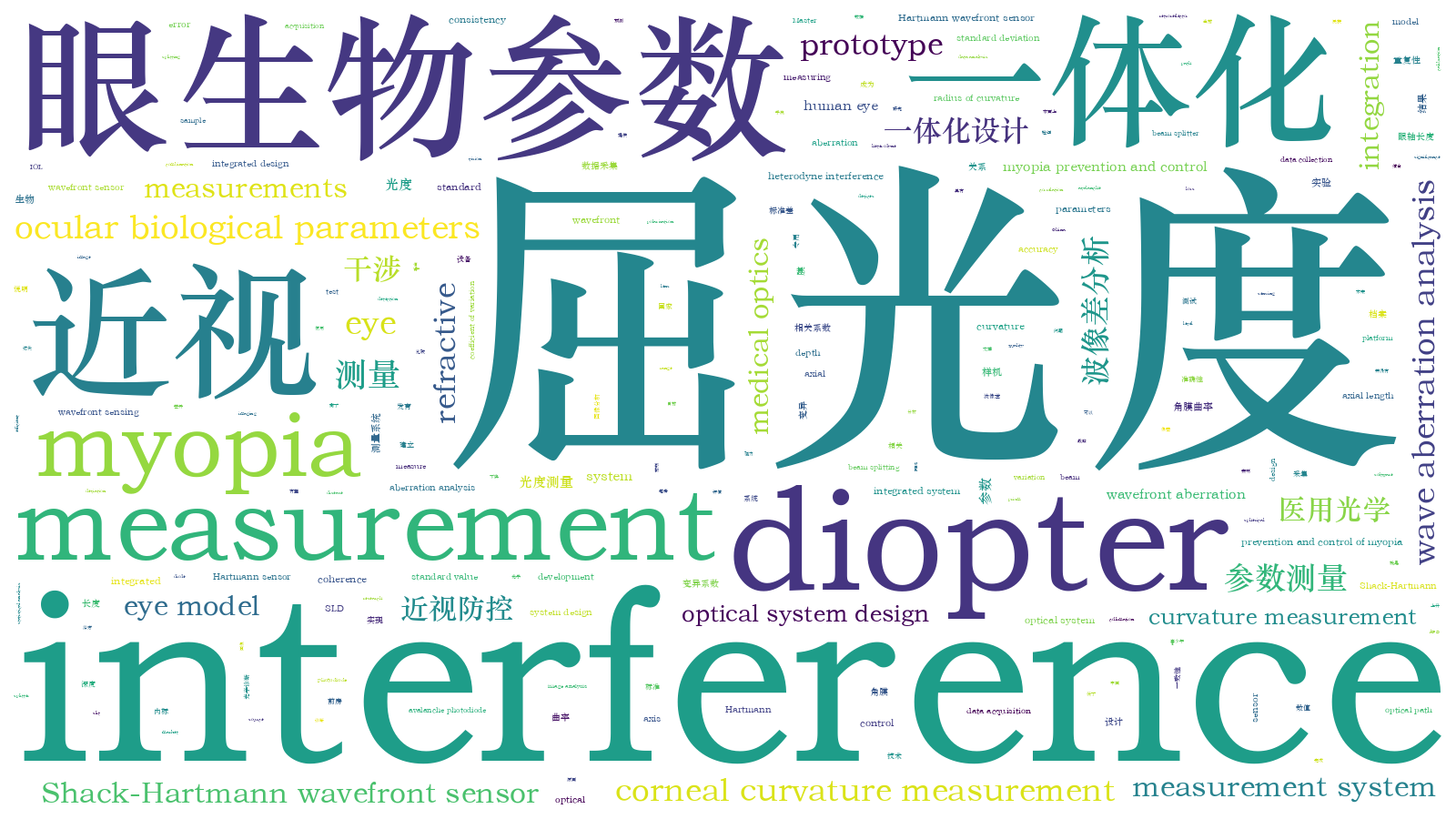眼屈光度与生物参数测量的一体化设计与实现
Myopia is a common eye disease that has reached an epidemic level of 90% among university students in China. It has emerged as the leading cause of vision loss in Chinese adolescents. Myopia prevention and control have become a social concern and a national strategy. Establishing refractive development files and predicting refractive error based on these data is one of the most efficient ways to prevent and control myopia. There are many ocular biometric measuring instruments and optometers in the market, but there are no devices dedicated to the data acquisition of refractive development files. Based on previous research, this study combined interference, wavefront aberration, and image analysis to establish an integrated measurement system of ocular refraction and biological parameters, mainly measuring parameters including the axial length (AL), corneal curvature (K), anterior chamber depth (ACD), and diopter. We hope to provide an integrated, automated, and intelligent data collection, storage, and analysis platform for the refractive development of myopia prevention and control.
An integrated system for the measurement of the ocular refractive error and ocular biometry consists of a Twyman-Green low-coherence interference subsystem and a Shack-Hartmann wavefront sensing subsystem (Fig.1). A super-luminescent diode (SLD), beam splitter (BS), prism retroreflector, polarization beam splitting (PBS), and avalanche photodiode (APD) compose the Twyman-Green low-coherence interference subsystem. The SLD of the Twyman-Green low-coherence interference subsystem, lens relaxed optical path, and Shack-Hartmann wavefront sensor form the ocular refractive error-measuring optical subsystem. The axial length of the human eye was measured based on the Twyman-Green low-coherence interference system. Corneal reflex imaging was used to measure the corneal curvature. Measurement of anterior chamber depth is achieved in combination with slit lamp and corneal curvature measurement. The integrated design was applied in the optical system design and fused wavefront aberration analysis and interference optical paths; the strict collimation SLD could be a shared source to achieve wavefront aberration analysis and eye-axis measurement. Diopter measurements were calibrated using standard model eyes to ensure the accuracy of the measurement results. The biological parameters of the human eye (AL, K, and ACD) and diopter (spherical and cylindrical degrees) were measured five times for each subject using the experimental prototype and IOL Master 500, respectively. All statistical analysis were performed using SPSS 25.0 software. The repeatability of the experimental prototype measurements was evaluated using the within-subject standard deviation(Sw), test-retest repeatability (TRT), coefficient of variation (CoV), and intra-group correlation coefficient (ICC). The measurement results of the experimental prototype and IOL Master 500 were compared to analyze their accuracy and consistency.
Five volunteers were recruited inside the laboratory, and the operator measured the subject’s left eye using the system experimental prototype and randomly showed the result of the eye axis length, radius of curvature, anterior chamber depth, and images of the measured human eye on the wavefront aberration sensor (Fig.3, Fig.4, Fig.5, Fig.6). The quality of the acquired images was good. The experimental prototype was used to measure the standard eye model with different diopters. The results of the single-sample t-test showed that the significance of the P value was greater than 0.05 (Table 1), and there was no difference between the diopter detection value of the experimental prototype and the standard value of the standard eye model, indicating that the experimental prototype could ensure measurement accuracy. From the values of Sw and TRT, it can be deduced that both the ocular biological parameters and diopter measurements have high repeatability. The CoV of eye biological parameters was less than 3%, the variation in the axial length and corneal curvature was smaller (CoV is less than 0.256%), and the ICC was higher than 0.6, reflecting high consistency (Table 2). The Bland-Altman analysis of the eye axis length, radius of curvature, and anterior chamber depth measured by the experimental prototype and IOL Master 500 showed no significant difference (P>0.05); the difference range was very small, and the 95% consistency limit was -0.045-0.056 mm, -0.037-0.056 mm, -0.534-0.355 mm, respectively, and all the measurement results were within the consistency interval (Table 3).
In this study, we designed an ocular refractive and biometric measurement system based on the Hartmann sensor and low-coherence heterodyne interference. Following previous studies, a standard eye model was used as the calibration sample to observe the diopter measurement results of the system. From the result analysis, it can be concluded that the results of this prototype measurement were highly consistent with the IOL Master 500 measurement results, and there was no significant difference in the results. The results showed excellent consistency of the ocular biological parameters and refractive measurements obtained using the integrated experimental prototype and IOL Mater 500. With the development of technology, it will be possible to provide special refractive file data acquisition for the prevention and control of myopia. In the future, we hope to provide an integrated, automated, and intelligent data collection, storage, and data analysis platform for refractive developmental files for myopia prevention and control.
王成, 朱俊, 熊利能, 董建荣, 戴磊, 项华中, 陈明惠, 郑刚, 赵婕, 张大伟. 眼屈光度与生物参数测量的一体化设计与实现[J]. 中国激光, 2023, 50(9): 0907208. Cheng Wang, Jun Zhu, Lineng Xiong, Jianrong Dong, Lei Dai, Huazhong Xiang, Minghui Chen, Gang Zheng, Jie Zhao, Dawei Zhang. Integrated Design and Implementation of Ocular Diopter and Biological Parameters Measurement[J]. Chinese Journal of Lasers, 2023, 50(9): 0907208.







